中国典籍英译概述57页PPT
- 格式:ppt
- 大小:6.44 MB
- 文档页数:3
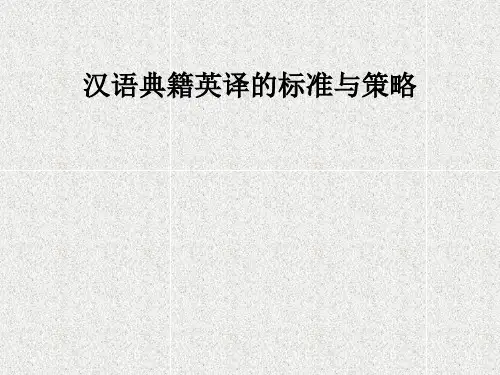
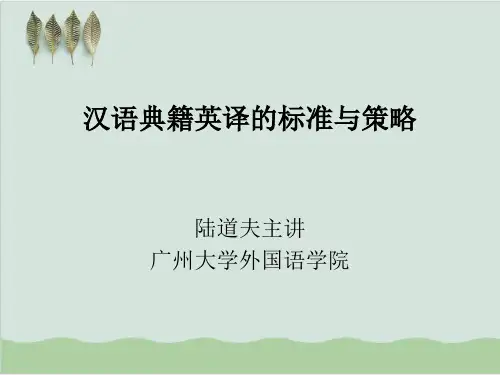
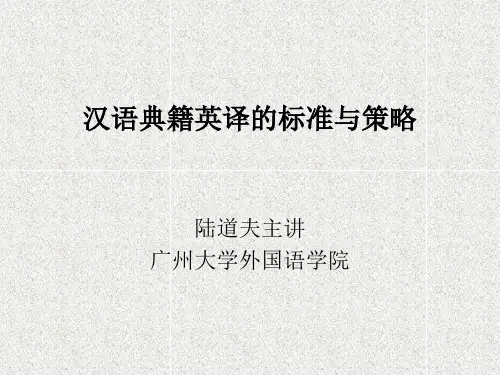
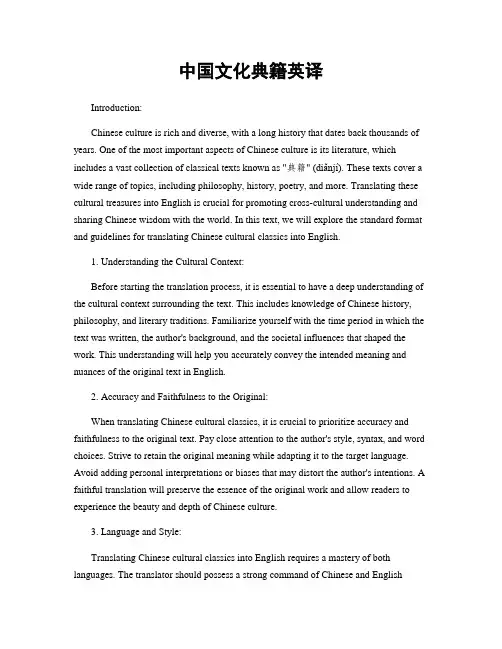
中国文化典籍英译Introduction:Chinese culture is rich and diverse, with a long history that dates back thousands of years. One of the most important aspects of Chinese culture is its literature, which includes a vast collection of classical texts known as "典籍" (diǎnjí). These texts cover a wide range of topics, including philosophy, history, poetry, and more. Translating these cultural treasures into English is crucial for promoting cross-cultural understanding and sharing Chinese wisdom with the world. In this text, we will explore the standard format and guidelines for translating Chinese cultural classics into English.1. Understanding the Cultural Context:Before starting the translation process, it is essential to have a deep understanding of the cultural context surrounding the text. This includes knowledge of Chinese history, philosophy, and literary traditions. Familiarize yourself with the time period in which the text was written, the author's background, and the societal influences that shaped the work. This understanding will help you accurately convey the intended meaning and nuances of the original text in English.2. Accuracy and Faithfulness to the Original:When translating Chinese cultural classics, it is crucial to prioritize accuracy and faithfulness to the original text. Pay close attention to the author's style, syntax, and word choices. Strive to retain the original meaning while adapting it to the target language. Avoid adding personal interpretations or biases that may distort the author's intentions. A faithful translation will preserve the essence of the original work and allow readers to experience the beauty and depth of Chinese culture.3. Language and Style:Translating Chinese cultural classics into English requires a mastery of both languages. The translator should possess a strong command of Chinese and Englishgrammar, vocabulary, and syntax. It is important to choose appropriate English equivalents for Chinese idioms, metaphors, and cultural references. Consider the target audience and aim for a style that is accessible and engaging. Maintain a balance between preserving the original text's literary qualities and ensuring readability for English-speaking readers.4. Footnotes and Annotations:Chinese cultural classics often contain references to historical events, figures, and cultural practices that may be unfamiliar to non-Chinese readers. To provide necessary context and enhance understanding, footnotes and annotations can be added to the translated text. Footnotes should be concise and provide explanations or additional information without interrupting the flow of the main text. Annotations can be used for more extensive explanations or discussions of specific cultural elements.5. Consistency and Coherence:Maintaining consistency and coherence throughout the translation is essential. Use consistent terminology for recurring concepts, names, and phrases. Pay attention to the logical flow of ideas and ensure that the translated text reads smoothly and coherently. Consider the overall structure of the text and how individual sections relate to each other.A well-structured translation will help readers navigate the complexities of the original work and fully appreciate its cultural significance.6. Editing and Proofreading:Once the translation is complete, thorough editing and proofreading are necessary to ensure accuracy and quality. Review the translated text for any grammatical errors, typos, or inconsistencies. Verify that the translation accurately reflects the original text's meaning and intent. Consider seeking feedback from native speakers or experts in the field to further refine the translation. A well-edited and polished translation will enhance its credibility and readability.Conclusion:Translating Chinese cultural classics into English is a challenging yet rewarding endeavor. It requires a deep understanding of both Chinese and English languages, as well as a profound knowledge of Chinese history and culture. By following the standard format and guidelines outlined above, translators can accurately convey the beauty and wisdom of Chinese literature to a global audience. Through these translations, we can bridge cultural gaps and foster a greater appreciation for the richness of Chinese culture.。
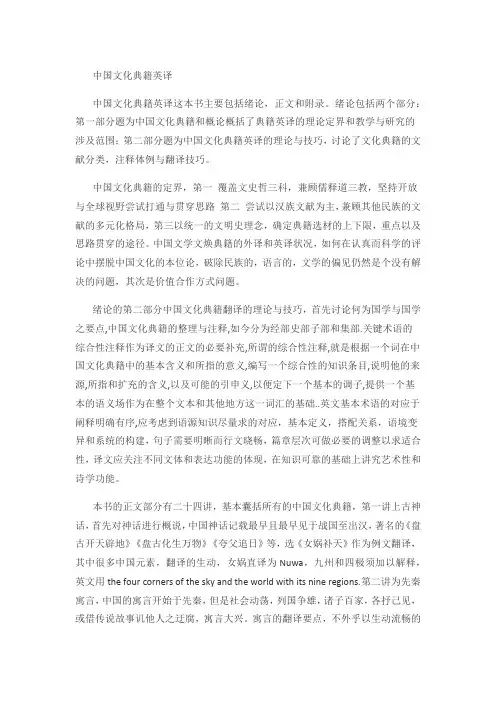
中国文化典籍英译中国文化典籍英译这本书主要包括绪论,正文和附录。
绪论包括两个部分:第一部分题为中国文化典籍和概论概括了典籍英译的理论定界和教学与研究的涉及范围;第二部分题为中国文化典籍英译的理论与技巧,讨论了文化典籍的文献分类,注释体例与翻译技巧。
中国文化典籍的定界,第一覆盖文史哲三科,兼顾儒释道三教,坚持开放与全球视野尝试打通与贯穿思路第二尝试以汉族文献为主,兼顾其他民族的文献的多元化格局,第三以统一的文明史理念,确定典籍选材的上下限,重点以及思路贯穿的途径。
中国文学文焕典籍的外译和英译状况,如何在认真而科学的评论中摆脱中国文化的本位论,破除民族的,语言的,文学的偏见仍然是个没有解决的问题,其次是价值合作方式问题。
绪论的第二部分中国文化典籍翻译的理论与技巧,首先讨论何为国学与国学之要点,中国文化典籍的整理与注释,如今分为经部史部子部和集部.关键术语的综合性注释作为译文的正文的必要补充,所谓的综合性注释,就是根据一个词在中国文化典籍中的基本含义和所指的意义,编写一个综合性的知识条目,说明他的来源,所指和扩充的含义,以及可能的引申义,以便定下一个基本的调子,提供一个基本的语义场作为在整个文本和其他地方这一词汇的基础..英文基本术语的对应于阐释明确有序,应考虑到语源知识尽量求的对应,基本定义,搭配关系,语境变异和系统的构建,句子需要明晰而行文晓畅,篇章层次可做必要的调整以求适合性,译文应关注不同文体和表达功能的体现,在知识可靠的基础上讲究艺术性和诗学功能。
本书的正文部分有二十四讲,基本囊括所有的中国文化典籍,第一讲上古神话,首先对神话进行概说,中国神话记载最早且最早见于战国至出汉,著名的《盘古开天辟地》《盘古化生万物》《夸父追日》等,选《女娲补天》作为例文翻译,其中很多中国元素,翻译的生动,女娲直译为Nuwa,九州和四极须加以解释,英文用the four corners of the sky and the world with its nine regions.第二讲为先秦寓言,中国的寓言开始于先秦,但是社会动荡,列国争雄,诸子百家,各抒己见,或借传说故事讥他人之迂腐,寓言大兴。
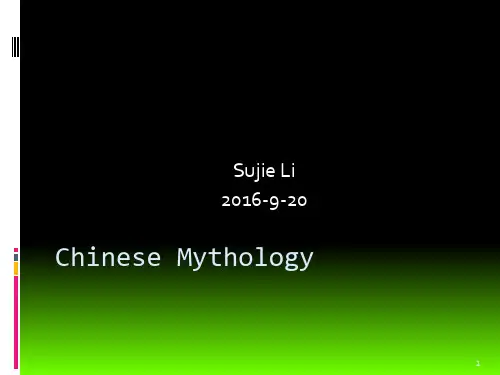
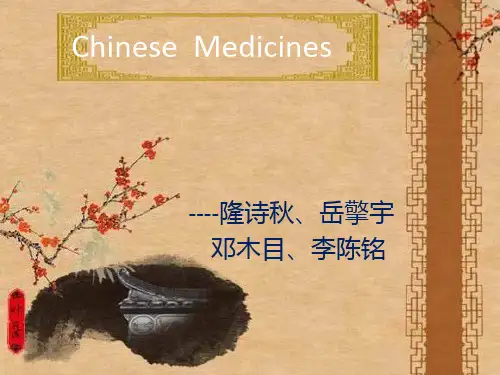

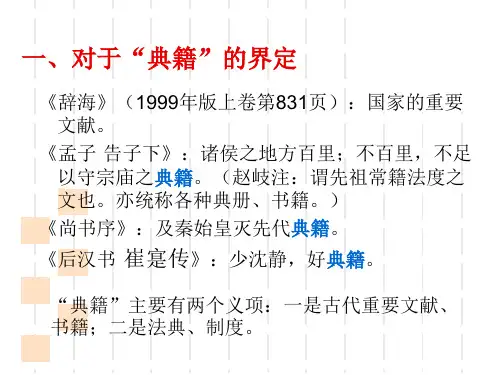
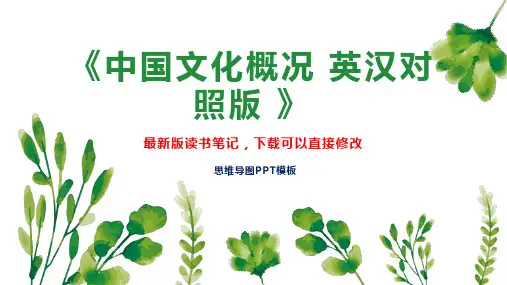

《中国典籍英译赏析》课程教学大纲课程代码:070142030课程英文名称:Appreciation of English Translation of Chinese Classics课程总学时:16 讲课:16 实验:0 上机:0适用专业:英语大纲编写(修订)时间:2017. 10一、大纲使用说明(一)课程的地位及教学目标《中国典籍英译赏析》是英语专业翻译方向高年级的选修课,本课程研究中国典籍英译的理论与技巧,通过赏析英译的中国典籍,旨在完善学生的翻译学科知识结构,有效提高口笔译实践能力、跨文化交际能力,学习中国传统文化,提高文学修养以及语言艺术修养。
(二)知识、能力及技能方面的基本要求本课程是一门综合英语技能课,主要通过中国典籍英译赏析和翻译训练,使学生逐步提高翻译理论与实践能力,掌握中国典籍英译的理论与技巧,具备一定的口笔译能力,并达到大纲所规定的写、译等技能的要求。
知识要求:1. 具有扎实的英语语言基本功;2. 熟练掌握英语翻译基本理论及方法;3. 具备一定的自然科学基础知识及较扎实的相关人文和社会科学知识。
能力要求:1. 具有较强的学习能力、英语综合运用能力和英语文学鉴赏能力;2. 跨文化交际能力;3. 能运用相关的专业知识发现、分析、解决问题的能力;4. 掌握科学的思维方法和研究方法及使用现代化手段获取信息和初步科学研究的能力;5. 具有较强的社会适应能力;6. 具有创新意识和创业的基本品质及实践能力。
技能要求:1.初步了解中国典籍翻译基础理论和英汉两种语言的文化差异,并掌握常用的翻译技巧。
2.能翻译中等难度的中国典籍,译文要求忠实原意,语言流畅。
3. 具备一定的文学鉴赏能力。
(三)实施说明第六学期开设《中国典籍英译赏析》,教学时间为4周,每周4学时,总计16学时。
1. 教学方法; 本课要求教师在有限的教学时数内达到预期的教学目的,在教学中重视中国典籍英译赏析英译的理论与技巧及翻译实践训练,始终把能力培养放在首位。